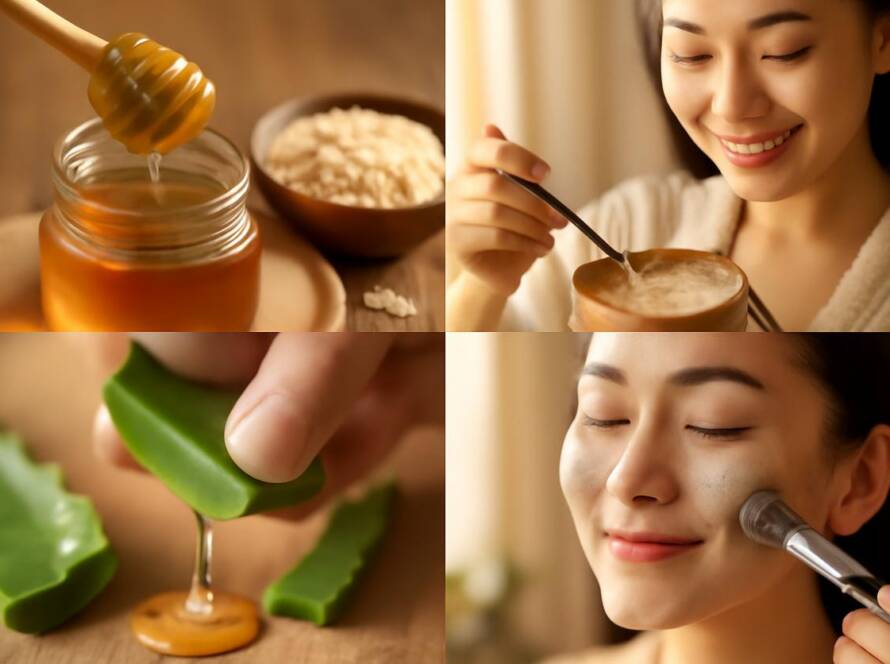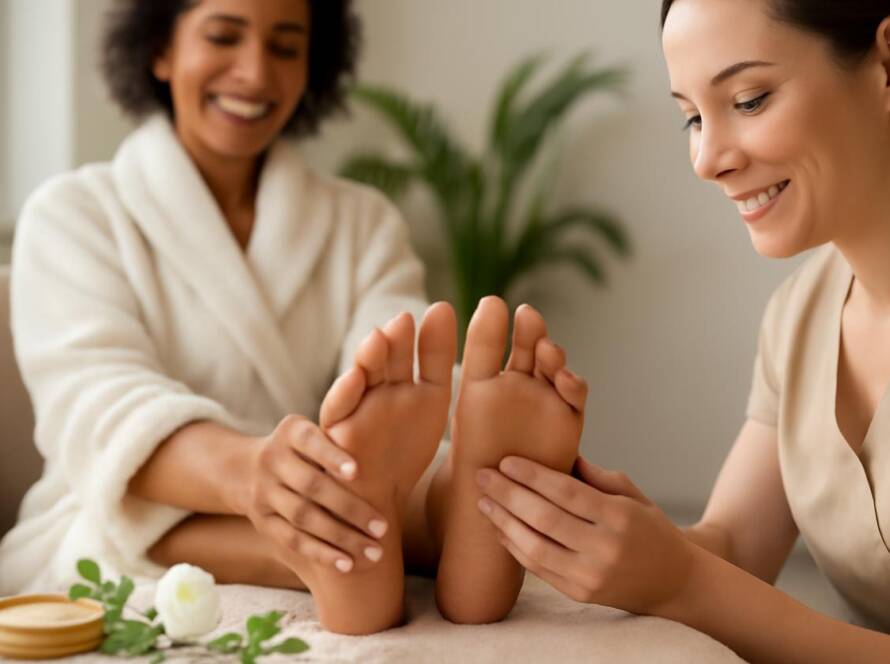What is LED Light Therapy and How Does it Work?
Once a technology reserved for dermatology clinics and NASA research, LED Light Therapy has become one of the most accessible and talked-about non-invasive skin treatments available for at-home use. But what is it, exactly? At its core, LED (Light Emitting Diode) therapy uses specific, non-UV wavelengths of light to penetrate the skin at varying depths, triggering natural biological processes that can heal, rejuvenate, and energize your cells.
Think of it like photosynthesis for your skin. Just as plants use sunlight to create energy, your skin cells can use these specific light wavelengths to stimulate repair and renewal. Unlike harsh treatments that work by creating controlled damage, LED Light Therapy is a gentle, regenerative process that supports your skin’s innate functions.
The Science Behind the Glow: How Wavelengths Affect Skin Cells
The magic of LED therapy lies in its different colors, or wavelengths, which are measured in nanometers (nm). Each wavelength reaches a different layer of the skin and prompts a unique cellular response, primarily by stimulating the mitochondria—the powerhouses of your cells.
- Red Light (~630nm – 660nm): This popular wavelength penetrates deeper into the skin, reaching the dermis where your collagen and elastin are produced. It stimulates fibroblasts to produce more collagen, leading to firmer skin, reduced fine lines, and improved circulation. It’s the go-to for anti-aging.
- Blue Light (~415nm – 465nm): Blue light has a shorter wavelength and works on the surface of the skin. Its primary benefit is its powerful antibacterial properties. It targets and eliminates the C. acnes bacteria, a major contributor to breakouts, making it an excellent treatment for mild to moderate acne.
- Near-Infrared (NIR) Light (~830nm and up): Invisible to the naked eye, NIR penetrates deepest of all. It works to reduce inflammation, accelerate wound healing, and can boost the effects of red light for more profound rejuvenation and pain relief.
When these light particles are absorbed by the skin, they convert into energy, boosting the production of adenosine triphosphate (ATP). This increase in cellular energy supercharges cell performance, leading to enhanced repair, regeneration, and overall healthier skin function.
The Clinical Evidence: What Do Studies Say About LED Light Therapy?
The excitement around LED Light Therapy isn’t just hype; it’s backed by a growing body of scientific research. While at-home devices are less powerful than their clinical counterparts, they operate on the same principles that have been validated in numerous studies. The key to success is consistency and using a device with clinically-proven wavelengths.
Highlights from Scientific Research
A wealth of studies, many of which can be explored on platforms like the National Library of Medicine’s PubMed, have demonstrated the efficacy of this technology. Research has consistently shown that:
- Red light therapy can significantly improve skin complexion, skin tone, and collagen density.
- Blue light therapy is effective in reducing the number of acne lesions and can minimize inflammation associated with breakouts.
- Combination treatments using both red and blue light often yield superior results for acne, as they simultaneously target bacteria and reduce inflammation.
These studies underscore that LED Light Therapy is not a cosmetic fad but a therapeutic modality with measurable biological effects. For more detailed information, you can explore peer-reviewed LED light therapy studies to understand the specific parameters and outcomes.
Key Benefits of At-Home LED Light Therapy
Incorporating LED therapy into your routine can address some of the most common skin concerns gently and effectively. The main appeal is its ability to deliver targeted results without downtime or irritation.
Targeting Acne and Inflammation
For those struggling with persistent breakouts, blue LED Light Therapy offers a drug-free alternative. By killing acne-causing bacteria on the skin’s surface, it helps clear existing blemishes and prevent future ones. When paired with red light, it also calms the associated redness and inflammation, promoting faster healing of acne spots.
Rejuvenating Aging Skin
Red and near-infrared light are the power players for anti-aging. By stimulating collagen and elastin production, regular sessions can help:
- Soften the appearance of fine lines and wrinkles.
- Improve skin firmness and elasticity.
- Enhance overall skin radiance and texture.
Addressing Hyperpigmentation and Tone
While red light’s ability to reduce inflammation and boost circulation can contribute to a more even skin tone, some devices also incorporate green light (~525nm). Green light targets melanocytes, the cells that produce melanin, potentially helping to break up clusters of pigment and fade dark spots. However, research in this area is less extensive than for red and blue light.
Debunking Common Myths About LED Light Therapy
As with any popular treatment, misconceptions abound. Let’s clarify a few common ones.
- Myth 1: It’s the same as UV light. This is completely false. LED therapy uses specific, non-UV wavelengths that do not tan or damage the skin. It is a gentle, therapeutic light.
- Myth 2: Results are instant. LED therapy works at a cellular level, and these changes take time. Consistency is crucial, with most users seeing noticeable results after several weeks of regular use.
- Myth 3: Any colored light bulb will work. The effectiveness of LED Light Therapy depends on using very specific, clinically-proven wavelengths. A standard colored bulb does not emit the precise nanometers needed to penetrate the skin and trigger a cellular response.
Safety First: Your Pre-Use Checklist for LED Light Therapy
LED therapy is widely considered safe for most skin types, but it’s essential to follow safety protocols. Before starting, review this checklist, and for general skin health questions, the American Academy of Dermatology is a reliable resource.
Understanding Contraindications
You should avoid or speak with a doctor before using an LED device if you:
- Are pregnant or breastfeeding.
- Have a history of seizures or epilepsy.
- Are taking photosensitizing medications (e.g., certain antibiotics, retinoids like isotretinoin).
- Have an active skin condition like a rash, or have suspicious or cancerous lesions.
Protecting Your Eyes
The light from LED devices can be very bright. While there is no evidence of permanent eye damage from at-home devices, it’s crucial to protect your eyes. Always use the opaque goggles that come with your device or keep your eyes closed during treatment.
Your Practical At-Home LED Routine: A Step-by-Step Guide
Creating a consistent and effective LED routine is simple. For a forward-looking skincare strategy in 2025 and beyond, focus on integrating this technology seamlessly into your existing habits.
Step 1: Pre-Treatment Preparation
Start with a clean canvas. Thoroughly cleanse your face to remove all makeup, sunscreen, and skincare products. Pat your skin completely dry. Any residue can block the light from penetrating effectively.
Step 2: During Your Session
Place your device as directed by the manufacturer—this could be a mask you wear or a panel you sit in front of. Follow the recommended treatment time, which is typically between 3 and 20 minutes, depending on the device. Relax, listen to a podcast, and let the light work its magic.
Step 3: Post-Treatment Care
After your session, proceed with your regular skincare routine. This is a great time to apply hydrating serums (like hyaluronic acid), antioxidants, and moisturizers, as your skin may have enhanced product absorption.
How to Choose the Right At-Home LED Device: A Decision Checklist
The market is flooded with options, making it hard to choose. Use this checklist to evaluate devices and find one that is safe, effective, and suited to your needs.
| Feature | What to Look For |
|---|---|
| FDA Clearance | Look for devices that are FDA-cleared. This indicates the device has been reviewed for safety and is substantially equivalent to a legally marketed device. |
| Specific Wavelengths | Ensure the device uses clinically-proven wavelengths: ~415nm for blue, ~630-660nm for red, and ~830nm for near-infrared. Vague terms like “red light” are not enough. |
| Irradiance (Power Density) | This measures the amount of light energy your skin receives (measured in mW/cm²). While not always advertised, reputable brands often provide this data. Higher irradiance can mean shorter treatment times. |
| Device Type | Choose based on your lifestyle. Masks offer hands-free convenience. Panels can treat larger areas like the face, neck, and chest. Wands are good for spot-treating. |
Maximizing Results: Integrating LED with Your Skincare Routine
What you put on your skin before and after your LED Light Therapy session can impact your results. The golden rule is to use the device on clean, bare skin.
What to Apply Before and After
- Before: Nothing. Cleanse thoroughly. Some brands offer specific activators, but in general, a clean slate is best. Avoid applying anything that could block light, such as heavy creams or oils. Also, do not use retinol or strong acids immediately before a session, as this can increase sensitivity.
- After: This is the perfect time to nourish your skin. Apply your serums, moisturizers, and eye creams. Hydrating and calming ingredients like hyaluronic acid, peptides, and niacinamide work beautifully post-treatment.
When to Consult a Professional
At-home LED Light Therapy is fantastic for maintenance and addressing mild to moderate skin concerns. However, it’s not a replacement for professional dermatological care. You should see a dermatologist if you:
- Have severe, cystic, or painful acne.
- Are concerned about significant signs of aging that don’t respond to at-home care.
- Have suspicious moles or lesions.
- Want to explore more powerful, in-office treatments.
Frequently Asked Questions (FAQ)
How often should I use my LED device?
Most manufacturers recommend using the device 3 to 5 times per week for the first 4-6 weeks, then reducing to 2 to 3 times per week for maintenance. Always follow the specific instructions for your device.
Does LED Light Therapy hurt?
No, it is a painless and relaxing treatment. You may feel a gentle warmth on your skin, but there should be no pain or discomfort.
When will I see results?
Patience and consistency are key. While some users notice a reduction in inflammation and a “glow” within a couple of weeks, more significant changes in acne and wrinkles can take 1 to 3 months of regular use.
Summary and Your Next Steps
LED Light Therapy is a powerful, science-backed tool that empowers you to take your skin’s health into your own hands. By understanding how different wavelengths work, committing to a consistent routine, and choosing a quality device, you can effectively address concerns like acne and signs of aging without irritation or downtime. It’s a gentle yet potent way to support your skin’s natural regenerative processes for a healthier, more radiant complexion.
Your next step is to use the decision checklist to research devices that align with your specific skin goals. By investing in the right technology and pairing it with a solid skincare routine, you can unlock a new level of skin vitality.



